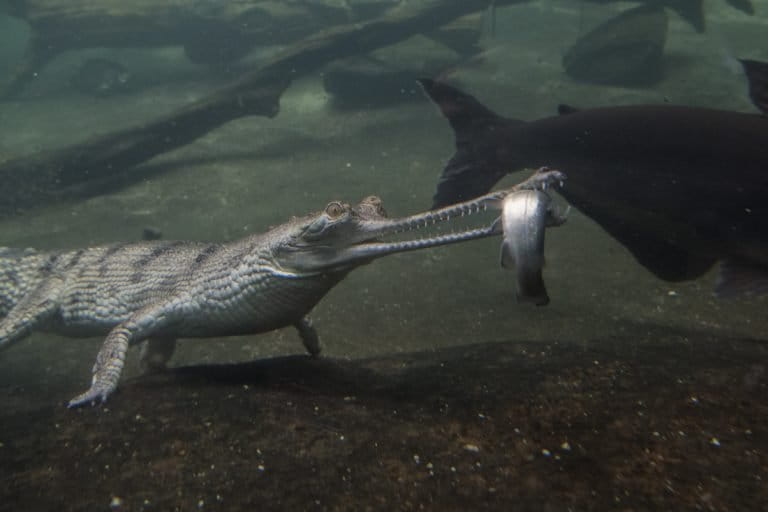
- Gharials are one of the world’s largest crocodilians and one of the rarest, having been extirpated from Pakistan, Bangladesh, Myanmar, and Bhutan.
- Their long, thin jaws evolved to help them catch fish in the rivers where they still live.
- With a river diversion project moving forward and with more wildlife tourists pouring into the region, Nepal’s gharials inside Bardia Park are at an important crossroads and need attention, a new commentary argues.
- This article is a commentary. The views expressed are those of the author, not necessarily of Mongabay.
Gharials (Gavialis gangeticus), are a strange and unique crocodilian. Although they’re one of the world’s largest crocodilians by mass, they also have comically thin jaws suited for catching fish rather than pulling down deer or other large terrestrial prey. They’re a unique lineage possibly also including the tomistoma as its only other extant member. Once gharials lived throughout the Indian sub-continent and surrounding areas.
Today gharials have been extirpated from Pakistan, Bangladesh, Myanmar, and Bhutan, suffering a population loss of approximately 98% since the 1940s. Inhabiting only about 2% of their historic range, most gharials today are found in India, with the largest population found in the Chambal River Sanctuary. This is understandably where most gharial conservation efforts are focused. However, populations of gharials in Nepal, especially the fragile but slowly recovering population in Bardia National Park should not be overlooked and deserve more attention.

New airports are being constructed in Nepal, aimed at bringing in more tourists. These make Bardia, with fairly recently improved bridge and road infrastructure more accessible than ever. Tourism is already a major economic force in Nepal, with a large chunk of it focusing on nature or ecotourism. Looking at major efforts such as Nepal’s success in growing tiger populations, it’s easy to think that this may have positive impacts on wildlife conservation efforts.
Even as tourism is set to bring more attention to Bardia National Park and its gharials, a river diversion project to be completed in 2023, poses unknown threats. Water from the Bheri River is being diverted to the Babai River to change the natural monsoonal fluctuations and provide year round irrigation water. The Bheri is also a colder river that will introduce new taxa to the Babai. The change in temperature, water levels and taxa will have an unknown impact on the gharials of the Babai river system.
Biologist Ashish Bashyal with Biodiversity Conservancy Nepal and colleagues recently published research in Aquatic Conservation: Marine and Freshwater Ecosystems discussing recommendations for the protection of gharials in Bardia and the surrounding areas. I believe this advice is timely as tourism in the area is set to receive a boom in new airports throughout Nepal and major river diversion projects are underway. It’s time to take the conservation of this smaller population of gharials more seriously for a healthy aquatic ecosystem in Nepal as well as for the stability of gharials as a species.
The populations of gharials inside of Bardia National Park are relatively small (no more than 19 animals in the Babai River) but important for a critically endangered species. Bashyal et. al, suggest more research focused on gharial reproduction and juvenile recruitment. There’s also a possibility that a local breeding facility could bolster the population. A baseline of the environment is important too, especially now as the environment is slated to soon change. Lastly, the researchers suggest facilitating gharial movement upstream of installed barrages and protection of the river downstream of Bardia National Park itself.
With the river diversion project moving forward and likely more tourists interested in wildlife pouring into the region, Bardia’s gharials are at an important crossroads. This is an important time for a population of these critically endangered crocodilians and all eyes should be on Bardia.
Zach Fitzner’s first book Tears for Crocodilia about the natural history and conservation of crocodilians will be published in May 2022 and is available for pre-order via Amazon and other retailers.
Banner image: Adult male gharial. Image by Charles J Sharp via Wikimedia Commons (CC BY-SA 4.0).
Nepal’s gharials deserve attention and protection (commentary)
Source: Trends News

0 Comments